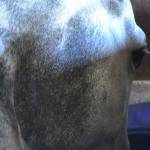Bran Mashes for Horses: When, Why and How?

Are bran mashes the barnyard equivalent to oatmeal: warm, filling, and soothing? Most horses dive into bran mashes with nary a flinch of hesitation after a day’s hard work. So what makes these warmed meals so palatable?
“The basis of any bran mash, as the name suggests, is bran. Though most horsemen talk these days of rice bran, which is a first-rate energy supplement, bran mashes are traditionally made with wheat bran, the hard outer layer of the wheat grain. Keep in mind that the dry weight of the bran should be no more than a pound or two,” said Catherine Whitehouse, M.S., a nutrition advisor at Kentucky Equine Research (KER).
With bran as the base, the only other necessary ingredient is water, boiling or nearly so. The amount of water and temperature of the water might be dependent on the horse—some horses might like a lukewarm sloppy mash, while others might prefer a steamy, solid mush. Once those primary ingredients are fully blended, the mixture must steep—typically covered with a lid—for at least 15 minutes. Before feeding, make sure the mash is not too hot.
Want to make the mash chunky, more flavorful? Slice carrots, fold in beet pulp, dice apples, drizzle peppermint, drop dollops of applesauce, whisk in molasses. Adding an electrolyte to a bran mash might be prudent if the horse has worked hard and produced sweat. The combination of ingredients is limited only by the imagination of the preparer.
Let’s take a closer look at some of the perceived benefits of a bran mash.
Fiber source. Though bran mash is sometimes given to horses for its fiber content, it contains little fiber compared to forage or beet pulp, according to Whitehouse. New strains of wheat are thought to have less fiber than older types, which would further reduce any fiber benefits.
Warming quality. While the mash might be served up as a toasty treat, it does nothing to warm the horse. This is better left to high-fiber feedstuffs and the machinations of the hindgut.
Laxative properties. Researchers have debunked any notion that a bran mash smooths passage of feedstuffs through the digestive tract, thereby helping to avoid colic. In fact, any change in manure after a bran mash might be due to a shift in the microbial population of the hindgut.
Introduction of water. A bran mash, especially a slushy one, will provide horses with water, and this is beneficial for horses that are not drinking. Assuming a horse’s appetite is normal, adding an ounce of salt to the feed could encourage water intake, too, recommended Whitehouse.
Adding the occasional bran mash to the diet should not disrupt normal digestive function. “If, however, a horse is particularly sensitive to dietary changes, bypassing the bran mash might be a safe choice. If this is the case, an owner might alternatively heat water and let the horse’s regular allotment of feed—whether it’s a sweet feed or pellets—soak in warm water,” Whitehouse suggested.
Keep calm and mash on!
Need feeding advice? Consult with a KER nutrition advisor today!








